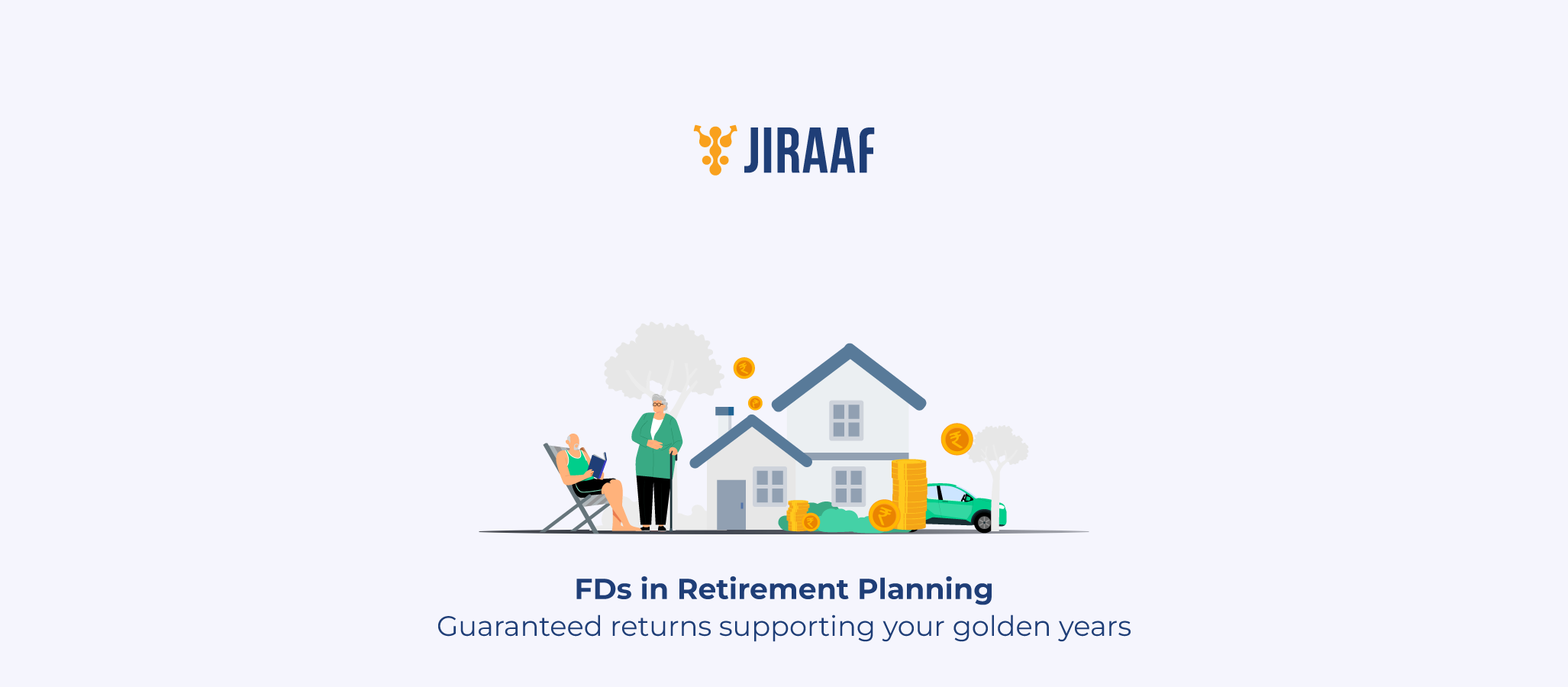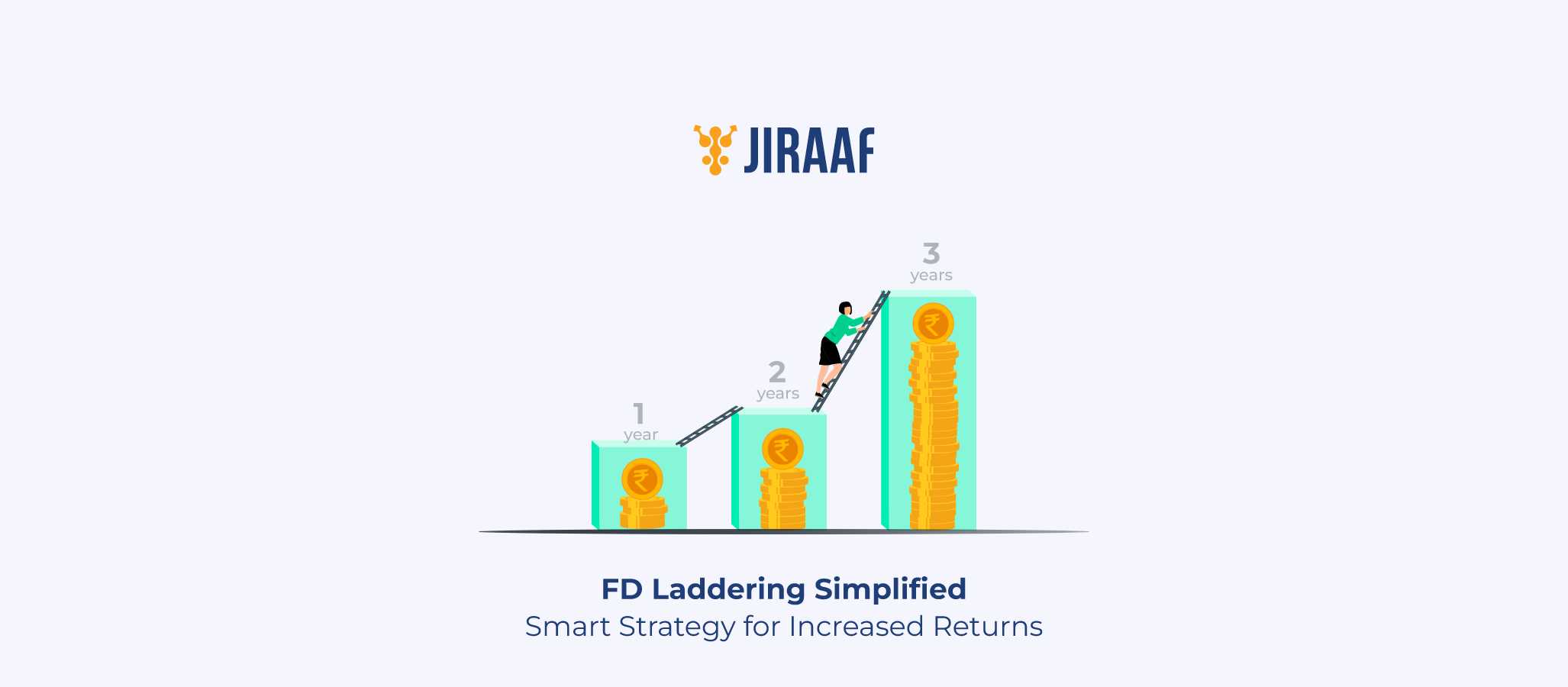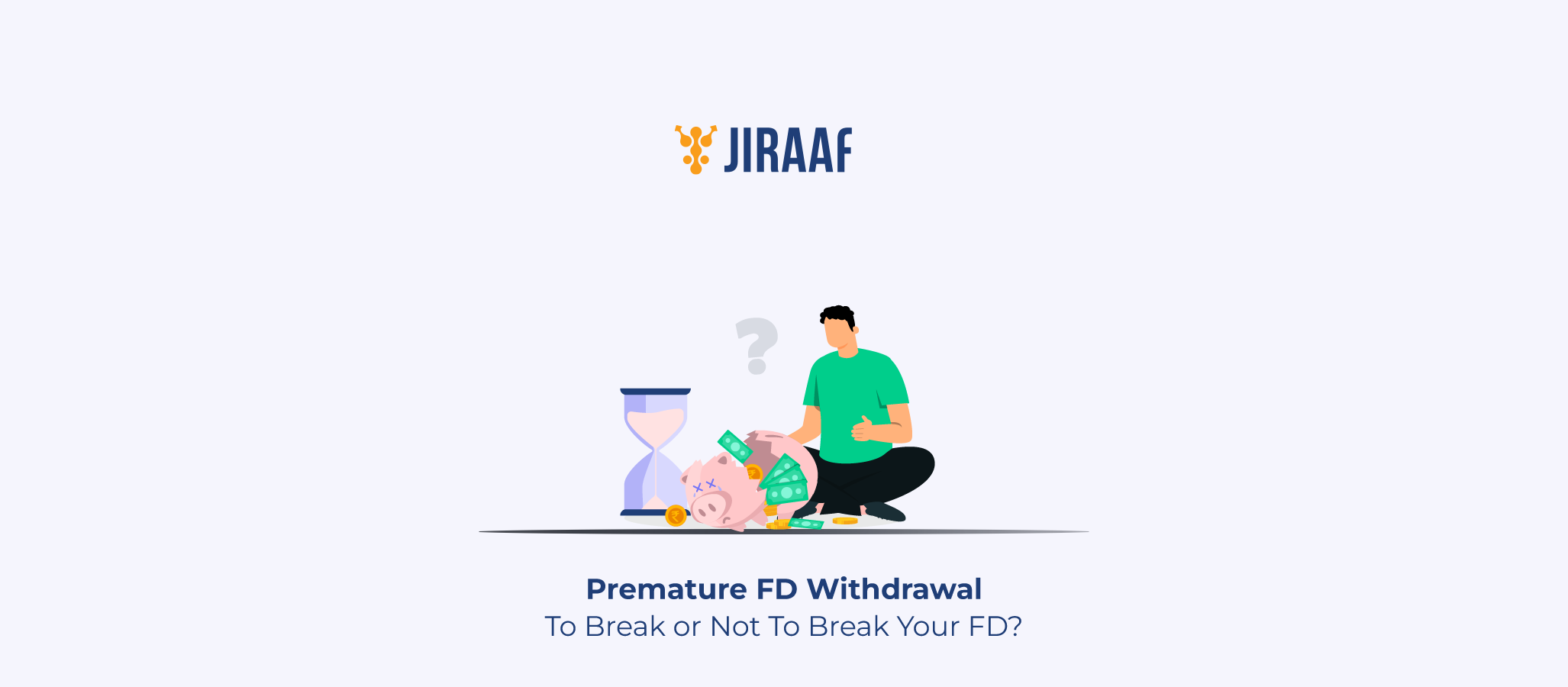The role of FDs in a retirement portfolio is something like that of salt in food. You might not notice them when they’re doing their job well, but you’ll certainly feel the gap if they’re missing. When planning for retirement, people generally shift their focus from capital appreciation to preservation, and FDs are the kings of preservation.
When planning for retirement, saving money is only one part; the other is to guarantee that your money stays secure for the future. FDs transcend generations, and despite a lot of flak for not beating inflation, they have survived the test of time, providing consistent stability and peace of mind to investors, especially retirees.
Although they don’t offer stock-market-level gains, FDs can be a strategic advantage to help you avoid financial stress and work in harmony with high-yielding assets. FDs guarantee that a portion of your savings stays accessible, trustworthy, and unaffected by market volatility, whether you’re using them to fund your regular expenses or unexpected medical bills.
In this article, we will discuss the role FDs play in your portfolio and overall retirement strategy, understand the benefits they come with, and learn how to use them wisely alongside other investments to achieve long-term financial independence and stability.
Why Fixed Deposits Are Ideal for Retired Individuals
Retirement brings about a change not just in your strategy but also in your investment philosophy, and FDs fit in seamlessly in it.
One of the strongest arguments in favour of FDs for retirees is the additional interest rate benefit. Most banks offer 0.5% higher interest to senior citizens, which significantly boosts returns over time.
Also, there are some interesting options from smaller banks and non-banking financial companies (NBFCs) if you want to make more money without significantly compromising on safety. Additionally, retirees can enhance liquidity by pairing fixed deposits with a Systematic Withdrawal Plan (SWP) through mutual funds. An SWP allows you to withdraw a fixed amount regularly while keeping the remaining corpus invested, providing flexible and steady cash flow without the need to break fixed deposits prematurely. All things considered, fixed deposits are a reliable means of preserving both your financial security and your peace of mind in retirement.
Benefits of Income on Fixed Deposits After Retirement
FDs provide retirees a long list of benefits. One of the primary reasons retirees choose fixed deposits is for capital preservation. Unlike equity, the principal in an FD remains intact unless withdrawn early. Moreover, deposits up to ₹5 lakh per bank per individual are insured under the Deposit Insurance and Credit Guarantee Corporation (DICGC), which offers an additional layer of protection.
FDs also provide predictable and periodic income. If you opt for monthly or quarterly interest payouts, you can use them to cover routine expenses without dipping into your principal. Alternatively, cumulative FDs allow interest to compound, which can be useful for future needs like healthcare or gifting.
In situations like medical emergencies, FDs are easy to liquidate. You may incur a small penalty for premature withdrawal, but the funds are accessible quickly and without exposure to market risks. This liquidity ensures that a part of your portfolio remains responsive to unplanned needs without disturbing long-term investments like mutual funds or pensions.
For financially conservative retirees who prefer to avoid market uncertainty, FDs offer peace of mind and financial stability that few other instruments can match. In simple terms, FDs convert your retirement savings into a consistent income generator, transforming nest eggs into a reliable financial safety net for your golden years.
Tax-saving FD Schemes for Senior Citizens
For retirees aiming to optimize returns, tax efficiency is key. Fortunately, FDs come with a few tax-related advantages if structured wisely.
Tax-saving fixed deposits with a 5-year lock-in qualify for deductions under Section 80C, for up to ₹1.5 lakh per year. These are suitable for those who want to reduce taxable income and don’t need liquidity in the short term.
Under Section 80TTB, senior citizens can claim a deduction of up to ₹50,000 annually on interest earned from deposits with banks, post offices, or co-operative banks. This exemption is in addition to the benefits under Section 80C and directly improves the effective return from FDs.
If the total taxable income is below the exemption limit, investors can submit Form 15H to prevent Tax Deducted at Source (TDS) on interest income. This avoids unnecessary tax deductions and improves the post-tax returns.
By combining these options, senior citizens can retain the simplicity of FDs while enhancing their tax efficiency.
Comparing Fixed Deposits with Other Fixed-income Options
| Feature/ Instrument | Fixed Deposits | Senior Citizen Savings Scheme (SCSS) | Pradhan Mantri Vaya Vandana Yojana (PMVVY) | Post Office Monthly Income Scheme (POMIS) | Corporate Bonds | Government Bonds |
| Interest Rate (2025) | Up to 8.25% (senior citizen rates) | 8.2% (Q1 FY 2025) | ~7.4% | 7.4% | 6.5% – 8.5%+ (varies by issuer) | 6.8% – 7.5% approx. |
| Risk Level | Very Low (insured up to ₹5 lakh) | Very Low (government-backed) | Very Low (LIC-backed) | Very Low (government-backed) | Moderate to High (depends on issuer rating) | Very Low (sovereign guarantee) |
| Liquidity | Premature withdrawal allowed with penalty | Premature exit allowed after 1 year with penalty | 10-year lock-in | 5-year lock-in | Tradeable in secondary market | Tradeable in secondary market |
| Tax Treatment | Fully taxable; ₹50,000 exemption under Section 80TTB for seniors | Interest taxable; principal eligible for Section 80C deduction | Interest taxable; no Section 80C benefit | Interest taxable; no Section 80C deduction | Interest taxable; capital gains tax applicable if sold before maturity | Interest taxable; LTCG benefit if held >3 years |
| Notable Features | Flexible tenures; higher rates for seniors; insured by DICGC | Quarterly payouts; 5-year tenure (extendable) | Pension-like monthly/annual payouts | Monthly payouts | Potentially higher returns; credit and interest rate risk | Sovereign guarantee; subject to price volatility |
SCSS and PMVVY are excellent for fixed income but come with tighter rules and limits. Government and corporate bonds offer yield potential but carry price and credit risks. FDs, while more conservative, offer a middle ground with flexibility, moderate liquidity, and low risk.
FDs vs Bonds: Which One Offers Better Security for Retirees?
This primarily depends on your risk appetite. While government and AAA-rated corporate bonds can offer slightly higher returns, they are sensitive to interest rate movements. If you need to sell them before maturity, you may suffer capital loss.
FDs, in contrast, preserve both capital and returns. Even if you break an FD early, your principal is safe, and the penalty only affects interest, not the core investment. For retirees who value certainty and don’t want to track markets, this feature makes FDs the more comfortable choice.
Another point to consider is ease of access. Bonds require a demat account and an understanding of bond pricing and often come with lower liquidity in the secondary market. FDs are simple, accessible, and understood by all age groups.
Government-backed bonds particularly give you a balance of safety and higher returns.
Tax-free bonds, such as those from NHAI, yield around 7% tax-exempt returns.
Corporate bonds offer higher yields (8-10% for top-rated issuers such as L&T Finance), but they carry default risks and market volatility if sold before maturity.
Bonds, unlike FDs, trade in secondary markets, which can result in lower prices during rate hikes while also providing potential for capital gains.
Government bonds, like sovereign gold bonds (SGBs) or tax-free bonds, can complement FDs by providing greater tax efficiency and inflation protection, whereas corporate bonds are still too dangerous for most retirees.
What is the smarter approach? FDs can serve as your financial foundation with 60-70% of your fixed-income allocation, with bonds for around 30-40%. This balanced plan gives security while optimizing returns, allowing you to enjoy your retirement without worrying about market fluctuations or tax surprises.
How FDs Complement Other Retirement Investment Tools
Fixed deposits are not meant to replace other retirement investments but to work alongside them. While equities and mutual funds are needed to grow your wealth and fight inflation over the long term, FDs provide the necessary ballast—anchoring your portfolio during market volatility.
In combination with products like SCSS, PMVVY, and debt mutual funds, FDs can plug liquidity gaps, offer quick access to cash, and provide a buffer during downturns. This balance allows you to stay invested in growth assets without panic selling when markets drop.
Tips to Maximize FD Returns While Minimizing Taxes
- Use Form 15 G/H: This form is for people under 60 years of age with a total income below the taxable limit of ₹2.5 lakh under the old system and ₹4 lakh under the new system to avoid TDS on FD interest. Form 15H allows people who are 60+ years of age with income below ₹3 lakh to get an exemption from TDS on interest income up to ₹1 lakh each year.
- Implement Tenure Strategy: You should select FD tenures depending on the rates. When interest rates rise, consider 1-3 year fixed-term deposits to reinvest in higher yields. Lock in 5-year contracts when rates are at their peak (like the present 7-7.5% for seniors). Create an FD ladder with staggered maturities of 6, 12, or 24 months to maintain liquidity while capturing higher rates over time.
- Select the Right Banks: Small finance banks offer senior citizens 8.25%, which is 0.5-1% greater than typical banks. Always compare rates through the RBI’s FDRATES.in portal. Prioritize DICGC-insured banks to ensure complete ₹5 lakh protection per institution. Senior citizen discounts from SBI (7.5%) and HDFC (7.75%) frequently offer the highest safe returns.
- Opt for Interest Optimization: Monthly payment FDs are ideal for regular income demands when combined with systematic withdrawal plans (SWP) from debt funds to improve tax efficiency. For long-term goals, continuous FDs use compounding to increase effective returns. Always compare payout frequencies between banks.
Laddering Strategy for Liquidity and Better Yields
FD laddering is your secret weapon to fight fluctuating rates while safeguarding emergency access to cash. Here’s how to make the best out of it.
- The simple 3-rung ladder
Suppose you want to invest ₹15 lakh. You can divide it into three FDs with different maturities rather than putting it all into one. Here’s how it could look like:
- FD1: ₹5 lakh for a year at a 7.4% interest rate. This acts as an emergency fund.
- FD2: ₹5 lakh @ 7.6% for two years.
- FD3: ₹5 lakh at a 7.8% rate for three years.
This 3-rung FD ladder is an easy approach to manage your money wisely. This way, one FD matures annually, giving you continuous access to funds. If necessary, you can break just one FD without affecting the others, and you can reinvest each mature FD at more recent (and maybe even higher) rates. This way, you can balance flexibility, returns, and safety.
- Senior citizen special ladder
With your goals in mind, you might want to divide your ₹25 lakh post-retirement investment into five FDs of ₹5 lakh each:
- Six months: medical emergency fund.
- One year: family vacation.
- 18 months: maintenance or repairs for the house.
- Two years: health care planning or insurance premiums.
- Three years: grandchild’s education or a gift.
This laddering strategy keeps money handy and guarantees financial stability.
- Rising rate hedges
When the interest rates are rising you can adjust your ladder.
- Start by putting about 60% of your money into short-term FDs, like six-month or one-year term ones. This keeps your money ready and liquid.
- To lock in the greater returns, gradually switch to longer-term FDs (2–3 years) as interest rates peak. It’s an easy way to profit from rate cycles without having to watch the market.
This goal-based laddering approach keeps your investments secure and grows them while helping you stay ready for life.
Choosing the Right Payout Frequency
The right FD payout structure depends on your monthly income needs:
- Choose non-cumulative FDs (monthly or quarterly payouts) if you rely on interest income for routine expenses.
- Opt for cumulative FDs if you don’t need immediate income and want to let your money grow for future needs or emergencies.
Many retirees use a mix of the two by setting up non-cumulative FDs for regular living costs and cumulative ones for goals like legacy planning or future medical care.
Final Thoughts: Building a Reliable Retirement Income with FDs
Fixed deposits have long been seen through a narrow lens as instruments of safety. But in the context of retirement, they deserve to be reframed as tools of financial flexibility that adapt to your changing needs and life stages. They don’t just protect your capital but empower you to design income with intent.
If you want to plan for semi-retirement, a structured FD ladder can give you freedom without fear. If you’re looking to phase your gifting to the next generation, time-bound FDs can serve as planned legacies, and if you want to bridge a 5-year window before pension or annuity kicks in, an FD ladder aligned with that horizon solves the problem cleanly, without locking you in unnecessarily. FDs let you orchestrate control over your retirement plans silently, reliably, and on your terms. So, use them wisely, and make the most of what this asset has to offer in your retirement plans.
Discover fixed income investments with Jiraaf, a SEBI registered online bonds platform that educates and brings access to a wide array of bonds. Sign up today to explore diversified fixed income investment opportunities to support your goal-based wealth creation journey. Start investing!



